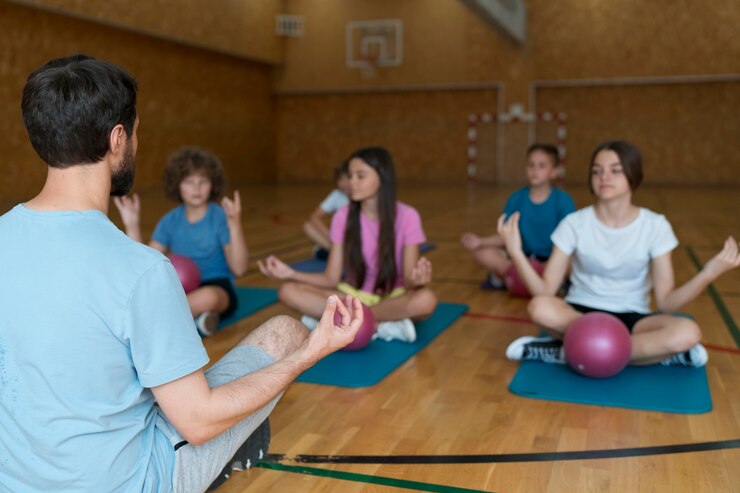
Introduction
Yoga has transcended its ancient roots to become a global practice embraced by millions. While many individuals can follow online classes or instructional videos, the instruction of a qualified yoga teacher offers unparalleled benefits. This article delves into the essential role of yoga teachers in instruction, emphasizing their impact on student safety, learning, and overall practice.
Understanding the Role of Yoga Teachers
Yoga teachers serve as guides and mentors, offering far more than just demonstrations of poses. Their instruction encompasses several key components:
1. Providing Personalized Guidance
Every individual has unique body mechanics, limitations, and goals. A skilled yoga teacher observes each student and provides personalized guidance through effective yoga teachers instruction, helping them achieve proper alignment and technique. This personalized guidance is crucial, especially for beginners who may not yet understand their bodies’ nuances.
2. Ensuring Safety and Correct Alignment
Safety is a primary concern in yoga practice. Teachers are trained to recognize common mistakes and misalignments that could lead to injury. They offer adjustments and modifications tailored to each student’s needs. This attention to safety fosters a supportive environment where students can explore their practice without fear of harm.
3. Fostering Mind-Body Connection
Yoga is inherently about connecting the mind, body, and spirit. Teachers guide students in developing mindfulness through breath awareness and meditation. This connection enhances the overall experience, allowing practitioners to become more aware of their physical sensations and emotional responses during practice.
The Benefits of Professional Instruction
Engaging with a trained yoga instructor can significantly enhance the practice for both beginners and seasoned yogis. Here are several benefits of professional instruction:
1. Enhanced Learning Experience
A professional instructor can provide a deeper understanding of yoga philosophy, techniques, and the purpose behind each pose. For instance, they can explain the significance of alignment in various asanas (poses) and how it affects the body. This comprehensive approach enriches the practitioner’s experience, turning a simple workout into a holistic journey.
2. Building Community
Participating in classes led by yoga teachers fosters a sense of community among practitioners. Sharing space with like-minded individuals creates camaraderie and support, which can enhance motivation and commitment to practice. Community classes also encourage dialogue and connection, enriching the overall experience.
3. Accountability and Motivation
Regular attendance in classes led by a teacher provides accountability. Knowing that a teacher will guide you can motivate students to show up consistently, thereby cultivating a steady practice. Additionally, teachers often challenge students to push their boundaries and explore new poses, fostering growth.
4. Addressing Individual Needs
Every practitioner has unique goals—some may seek to enhance flexibility, while others might focus on strength or stress relief. A qualified teacher can tailor classes to meet diverse needs, providing modifications and variations to accommodate different levels of experience and physical ability.
Choosing the Right Yoga Teacher
Finding the right yoga teacher can profoundly impact a practitioner’s journey. Here are some tips for selecting a qualified instructor:
1. Check Qualifications and Experience
It’s essential to look for instructors with recognized certifications from reputable yoga schools. Certifications indicate that the teacher has undergone training in anatomy, alignment, and the philosophy of yoga. Experience across various yoga styles can also enhance a teacher’s versatility and effectiveness.
2. Attend a Trial Class
Many yoga studios offer trial classes or introductory offers. Attending a few different classes allows you to gauge the instructor’s teaching style, personality, and how well they communicate. Observing how they interact with students and provide feedback can help determine if they are the right fit for you.
3. Consider Personal Goals
Identify your objectives for practicing yoga. Whether your goal is to relieve stress, build strength, or enhance flexibility, finding a teacher whose expertise aligns with your intentions is crucial. For example, if you’re interested in restorative practices, seek a teacher who specializes in restorative yoga.
4. Observe Class Environment
The class environment is also important. Observe whether the teacher fosters an inclusive, supportive, and respectful atmosphere. A positive and welcoming environment encourages students to ask questions and engage more fully in their practice.
Common Teaching Styles
Yoga teachers may adopt different teaching styles based on their training and personal philosophy. Understanding these styles can help you find a teacher that resonates with your practice:
- Hatha Yoga: Focuses on physical postures and breath control, suitable for beginners.
- Vinyasa Yoga: Emphasizes fluid transitions between poses, often set to music, and can be more dynamic.
- Yin Yoga: Involves holding poses for extended periods, promoting deep relaxation and flexibility.
- Ashtanga Yoga: A structured style involving a set sequence of poses, known for its intensity and discipline.
- Restorative Yoga: Focuses on relaxation and recovery, using props to support the body in gentle stretches.
Conclusion
The instruction of yoga teachers is essential for anyone looking to deepen their practice and ensure safety. Their expertise fosters a supportive environment that enhances the physical, mental, and spiritual benefits of yoga. By investing in the guidance of a qualified instructor, practitioners can unlock the full potential of their yoga journey.
Choosing the right yoga teacher can significantly influence your experience, ensuring that you receive personalized instruction and support. With the right guidance, yoga can become a transformative practice that enriches your life in numerous ways.







